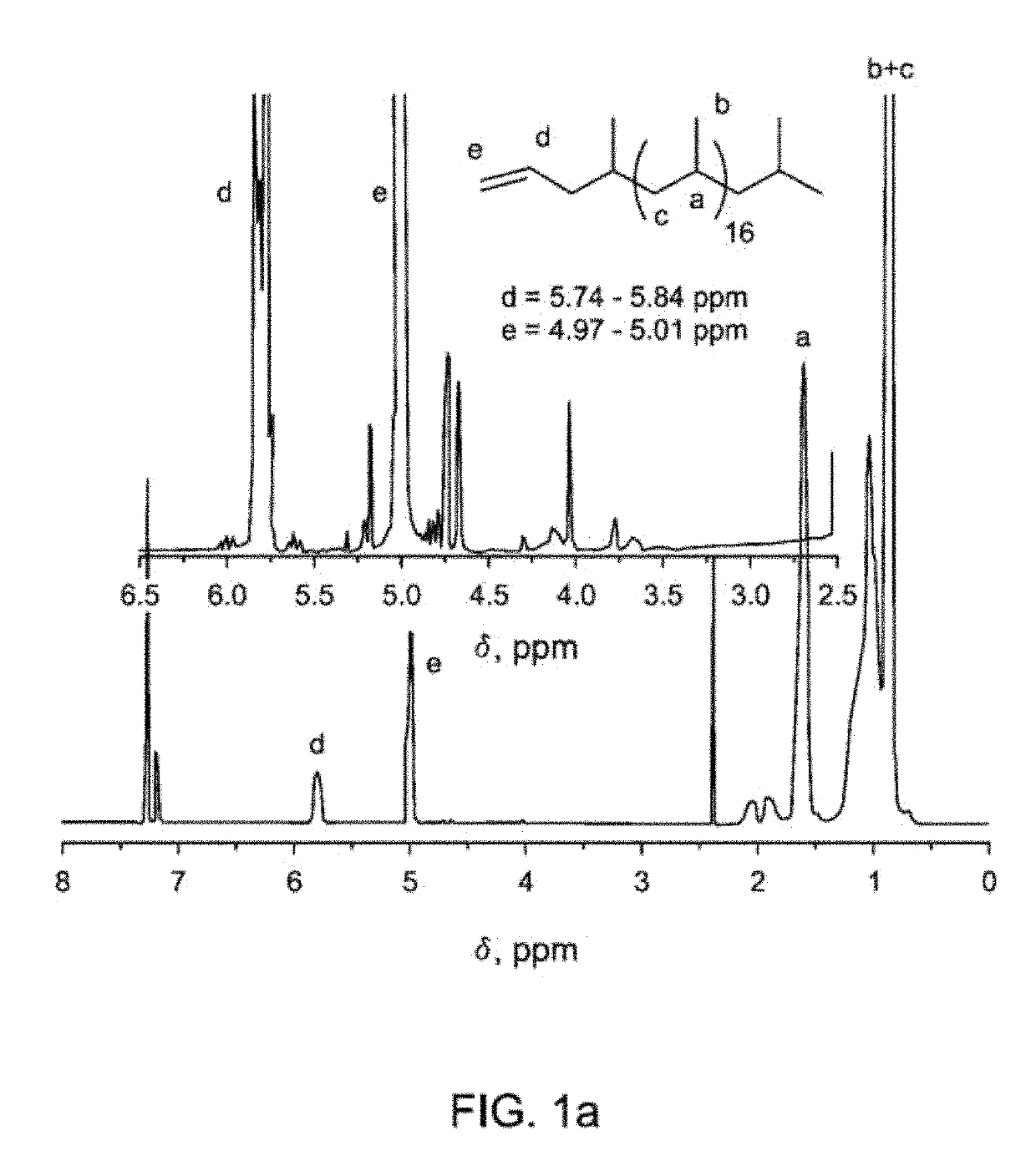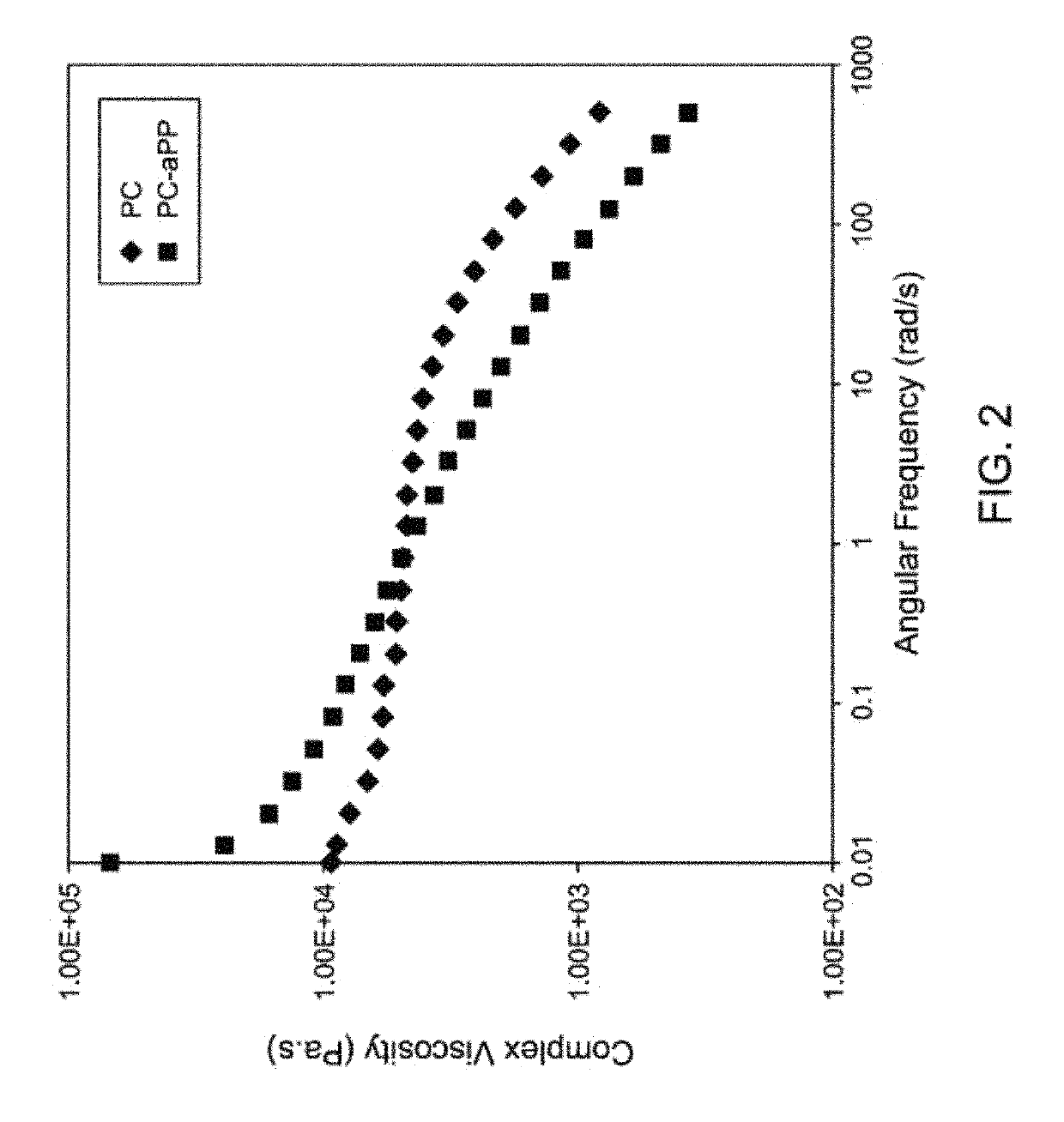Polycarbonate-polyolefin block copolymers and methods of making them
a polycarbonate and polyolefin technology, applied in the field of polycarbonate-polyolefin block copolymers, can solve the problems of poor processability, reduced toughness under low temperature, inadequate solvent and chemical resistance, etc., and achieves improved processability, low temperature properties, and stable morphologies.
- Summary
- Abstract
- Description
- Claims
- Application Information
AI Technical Summary
Benefits of technology
Problems solved by technology
Method used
Image
Examples
example 1
n of Phenol with Vinyl-Terminated Polypropylenes
[0124]
[0125]Vinyl-terminated atactic polypropylene (VT-aPP) was synthesized using organometallic coordinated polymerization as described generally in the scheme (8) above.
[0126]Alkylation of phenol was carried out with VT-aPP using BF3-etherate catalysis. In the general scheme (8), the “” symbol represents the aPP polymeric chain. For alkylation with VT-aPP, reactions were conducted either in hexane or cyclohexane at 55-70° C., whereas alkylation of VT-iPP would be carried out in toluene at 110-120° C. Depending on the molecular weights of VT-aPP, molar ratios of phenol:VT-aPP were varied from 10 to 100 for 800 g / mol VT-aPP to 6100 g / mol VT-aPP, respectively. Amounts of catalyst BF3-etherate were varied from 5-20 mol % based on phenol.
[0127]A three-neck round bottom flask equipped with a condenser, dropping funnel, and rubber septum was used for the alkylation of phenol with VT-aPP. Under nitrogen blanket, a VT-aPP solution in hexane / c...
example 2
of Phenylethylhydroquinone-Terminated Atactic Polypropylene (PhEtHQ-aPP)
[0131]
[0132]Attempts to directly alkylate hydroquinone (“HQ”) with VTPO failed, therefore a two-step alkylation was carried out, described generally in scheme (9), where, again, the “” symbol represents the aPP polymeric chain.
[0133]Phenylethylhydroquinone (PhEtHQ) was synthesized by alkylation of HQ with styrene using phosphoric acid as the catalyst. In a typical reaction, to a three-neck RBF equipped with a condenser and dropping funnel was charged with 1 mol HQ, followed by 3.5 mol phosphoric acid (75% in water), and 250 mL toluene. Styrene (0.95 mol) in 250 mL toluene solution was charged in the dropping funnel. The styrene solution was added dropwise to the heterogeneous mixture of HQ / phosphoric acid at 100-110° C. Addition was completed within 3-4 h and the reaction mixture was kept under vigorous stirring overnight. The next day, the hot reaction mixture was transferred to a separatory funnel. The upper l...
example 3
rocedure for Synthesis of PC Homopolymers and PC—PO Block Copolymers
[0135]
[0136]Melt polymerization was conducted in a glass reactor, which consisted of a round bottom flask, three-neck adaptor, overhead mechanical stirrer, and condenser according to the general scheme (10). The general scheme for the reaction is represented in scheme (10). Melt polycondensation of bisphenol-A (BPA) and diphenyl carbonate (DPC) was catalyzed by aqueous LiOH (25 ppm to 0.1 mol % based on BPA). In a typical reaction, BPA and DPC (1:1.1) were charged to the reactor followed by addition of LiOH as a catalyst. After evacuation for 10-15 minutes, the reactor was kept under continuous nitrogen purge and immersed in a molten alloy bath at 200° C. The reaction mixture was stirred with a mechanical stirrer at 100 rpm for 30-45 min. Then vacuum was applied slowly for about 15 min to remove the by-product phenol. After a significant amount of phenol distillation ceased, the temperature was ramped from 200 to 26...
PUM
| Property | Measurement | Unit |
|---|---|---|
| temperature | aaaaa | aaaaa |
| temperature | aaaaa | aaaaa |
| temperature | aaaaa | aaaaa |
Abstract
Description
Claims
Application Information
 Login to View More
Login to View More - R&D
- Intellectual Property
- Life Sciences
- Materials
- Tech Scout
- Unparalleled Data Quality
- Higher Quality Content
- 60% Fewer Hallucinations
Browse by: Latest US Patents, China's latest patents, Technical Efficacy Thesaurus, Application Domain, Technology Topic, Popular Technical Reports.
© 2025 PatSnap. All rights reserved.Legal|Privacy policy|Modern Slavery Act Transparency Statement|Sitemap|About US| Contact US: help@patsnap.com



